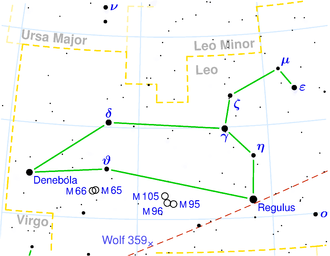NGC 3370
| Galaxie NGC 3370 | |
|---|---|
 | |
| Die Galaxie NGC 3370 aufgenommen vom Hubble-Weltraumteleskop | |
| AladinLite | |
| Sternbild | Löwe |
| Position Äquinoktium: J2000.0, Epoche: J2000.0 | |
| Rektaszension | 10h 47m 04,0s[1] |
| Deklination | +17° 16′ 25″[1] |
| Erscheinungsbild | |
| Morphologischer Typ | SA(s)c[1] |
| Helligkeit (visuell) | 11,7 mag[2] |
| Helligkeit (B-Band) | 12,4 mag[2] |
| Winkelausdehnung | 2,6′ × 1,5′[2] |
| Positionswinkel | 148°[2] |
| Flächenhelligkeit | 13,0 mag/arcmin²[2] |
| Physikalische Daten | |
| Zugehörigkeit | NGC-3370-Gruppe (Leo-II-Gruppe) LGG 219[3] |
| Rotverschiebung | 0,004266 ± 0,000013[1] |
| Radialgeschwindigkeit | (1279 ± 4) km/s[1] |
| Hubbledistanz vrad / H0 | (53 ± 4) · 106 Lj (16,4 ± 1,2) Mpc [1] |
| Masse | ca. 1011 M☉ |
| Geschichte | |
| Entdeckung | Wilhelm Herschel |
| Entdeckungsdatum | 21. März 1784 |
| Katalogbezeichnungen | |
| NGC 3370 • UGC 5887 • PGC 32207 • CGCG 095-019 • MCG +03-28-008 • IRAS 10444+1732 • 2MASX J10470403+1716253 • GC 2195 • H II 81 • h 750 • LDCE 0778 NED007 | |
NGC 3370 ist eine Spiralgalaxie vom Hubble-Typ Sc im Sternbild Löwe auf der Ekliptik. Sie ist rund 53 Millionen Lichtjahre von der Milchstraße entfernt und hat einen Durchmesser von etwa 45.000 Lichtjahren.
Das Objekt wurde am 21. März 1784 von dem deutsch-britischen Astronomen Wilhelm Herschel entdeckt.[4]
Am 14. November 1994 beobachtete S. Van Dyk am Leuschner Observatory Supernova Search eine Supernova in dieser Galaxie, welche die Bezeichnung SN 1994ae erhielt.[5] Diese Supernova vom Typ Ia war eine der am besten beobachteten Supernovae. Das Besondere an diesen Supernovae vom Typ Ia ist, dass sie als sogenannte Standardkerzen zur Bestimmung der Expansion unseres Universums dienen.
NGC 3370-Gruppe (LGG 219)
| Galaxie | Alternativname | Entfernung / Mio. Lj |
|---|---|---|
| NGC 3443 | PGC 32671 | 47 |
| NGC 3370 | PGC 32207 | 53 |
| NGC 3454 | PGC 38950 | 46 |
| NGC 3455 | PGC 32763 | 46 |
| PGC 32474 | PGC 32767 | 47 |
Weblinks
Einzelnachweise
Auf dieser Seite verwendete Medien
From original NASA press release:
- Amid a backdrop of far-off galaxies, the majestic dusty spiral NGC 3370 looms in the foreground in this NASA Hubble Space Telescope image. Recent observations taken with the Advanced Camera for Surveys show intricate spiral arm structure spotted with hot areas of new star formation. But this galaxy is more than just a pretty face. Nearly 10 years earlier, NGC 3370, located in the constellation Leo, hosted a bright exploding star.
The image was released on September 3, 2003 from 25 hours of exposures taken during April and May of 2003. It is labeled by NASA as "STScI-2003-24". Image Credit goes to NASA, The Hubble Heritage Team and A. Riess (STScI) This image is roughly 3.4 arcminutes (95,000 light-years or 29,000 parsecs) wide. Instrument: ACS/WFC (Advanced Camera for surveys/Wide Field camera) Filters: F435W(B), F555W(V), F814W(I)
This image is sharp enough to identify individual Cepheid variable stars in the galaxy.Autor/Urheber: Copyright © 2003 Torsten Bronger., Lizenz: CC BY-SA 3.0
This is a celestial map of the constellation Leo, the Lion.
NGC 3370





